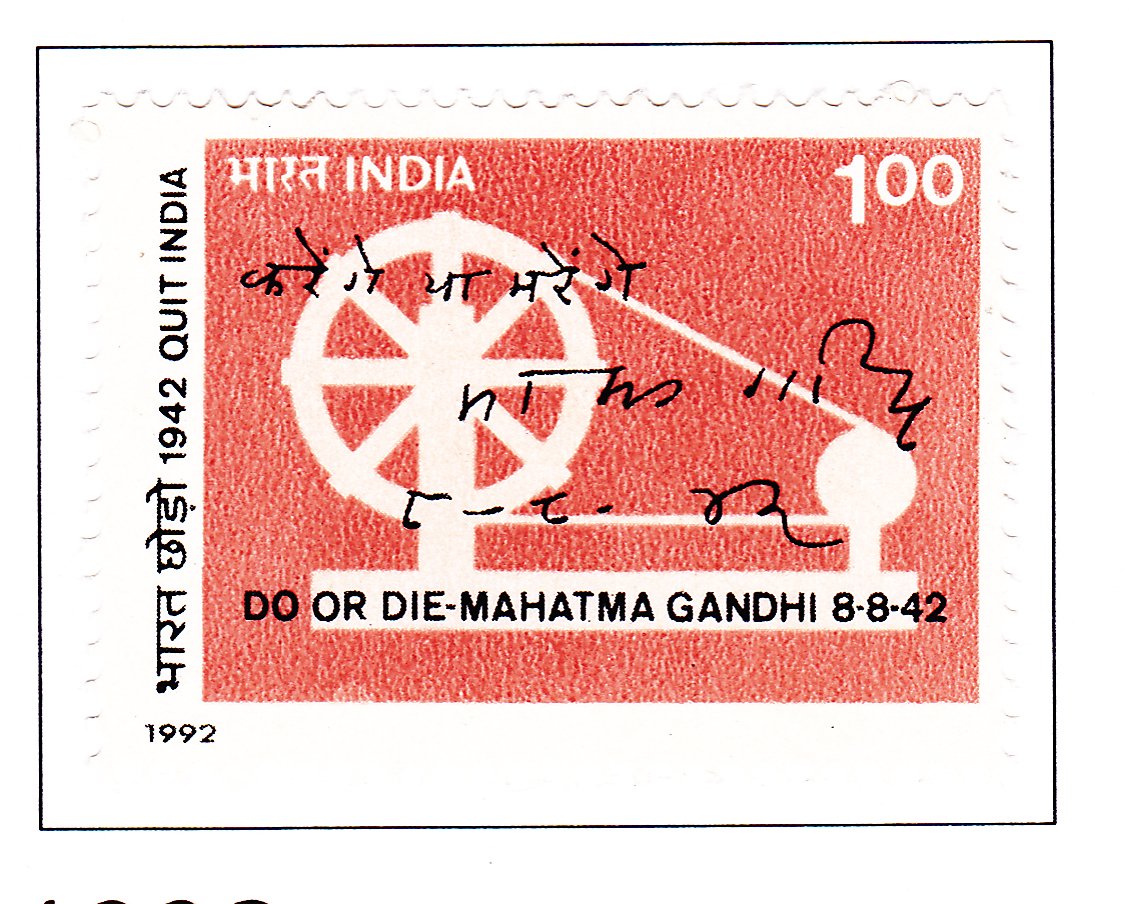Quit India – Do or Die-Mahatma Gandhi-Spinning Wheel Emblem

Technical Data
| Stamp Set | "Quit India" Movement |
|---|---|
| Date of Issue | August 9, 1992 |
| Denomination | Rs. 1 |
| Quantity | 600,000 |
| Perforation | comb 13½ x 13 |
| Printer | Security Printing Press, Nashik |
| Watermark | No Watermark |
| Colors | Multicolor |
| Catalog Codes |
Michel IN 1360 Stamp Number IN 1417 Yvert et Tellier IN 1158 Stanley Gibbons IN 1510 |
| Themes | Anniversaries and Jubilees | Seals(Emblems) |
Table of Contents
Commemorative Stamp Set: “Quit India Movement”
Design Elements:
- Main Image: Mahatma Gandhi delivering the speech with the iconic phrase “Do or Die” prominently featured.
- Background: A depiction of the August 8, 1942, meeting of the All-India Congress Committee in Bombay.
- Symbols: Images of the Indian flag, symbols of resistance such as placards from the Quit India Movement, and visuals representing mass protests.
- Text: The phrase “Do or Die” in both English and Hindi, along with a brief description of the Quit India Movement.
Cultural and Historical Significance:
- Historical Context: The stamp set commemorates the Quit India Movement, a crucial phase in India’s struggle for independence. The movement, led by Mahatma Gandhi, demanded the end of British rule in India and mobilized millions in a mass civil disobedience campaign.
- Cultural Impact: The “Do or Die” slogan became a symbol of the unwavering determination of the Indian people to achieve freedom, reflecting the courage and commitment of the leaders and masses involved.
Usage:
- Commemorative Value: This stamp set serves as a tribute to the pivotal role of the Quit India Movement in India’s history and highlights Gandhi’s leadership and the collective effort of the Indian people.
- Educational Tool: It can be used in educational contexts to teach about India’s fight for independence and the significance of Gandhi’s leadership and the Quit India Movement.
Importance of the Commemorative Stamp Set:
- Preservation of Legacy: The stamp set preserves the historical legacy of the Quit India Movement and Mahatma Gandhi’s pivotal role in it.
- Public Awareness: It raises awareness about the sacrifices made by the Indian people during this critical period and honors their contributions to India’s independence.
Example of the Stamp Design:
- Stamp 1: Features a portrait of Mahatma Gandhi with the “Do or Die” slogan and an image of him addressing the Congress Committee.
- Stamp 2: Depicts a crowd of protesters from the Quit India Movement, with the Indian flag and symbols of civil disobedience.
- First Day Cover: Shows a composite image of Gandhi’s speech and the historic meeting, with relevant dates and a commemorative cancellation mark.
- Cancellation Design: Features a graphic of the “Do or Die” slogan with a representation of the Indian tricolor and symbolic elements of the Quit India Movement.
The commemorative stamp set might include:
- Stamp 1 (100P): Gandhi delivering the speech with the “Do or Die” slogan.
- Stamp 2 (650P): Representation of the mass protests and civil disobedience.
- First Day Cover: Design incorporating elements of the Quit India Movement and Gandhi’s speech.
- Cancellation Mark: Reflecting the theme of the Quit India Movement and Gandhi’s message.
Significance:
This stamp set commemorates a defining moment in India’s quest for independence, celebrating the bravery and resolve of those who fought for freedom. It serves as a reminder of the sacrifices made and the enduring legacy of the Quit India Movement.
